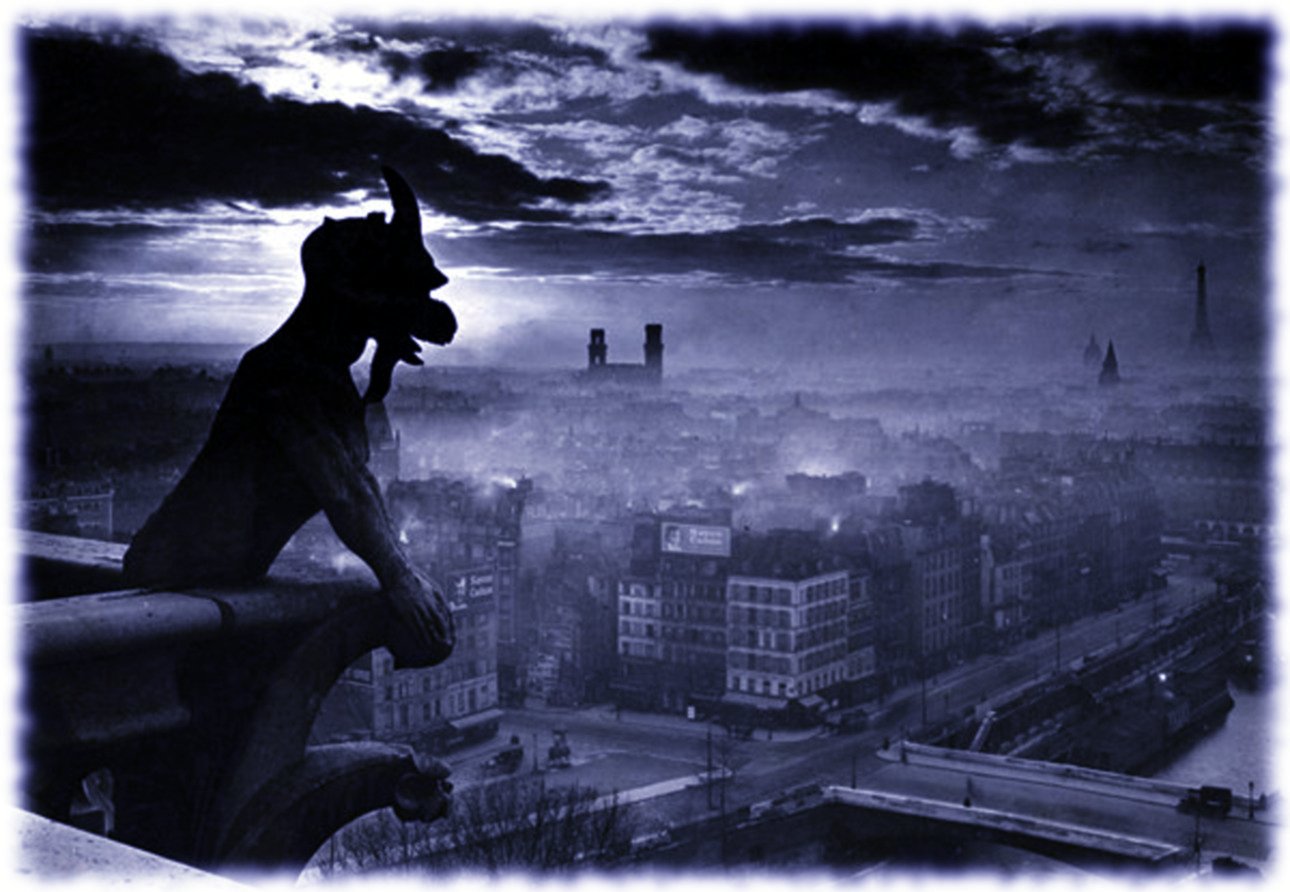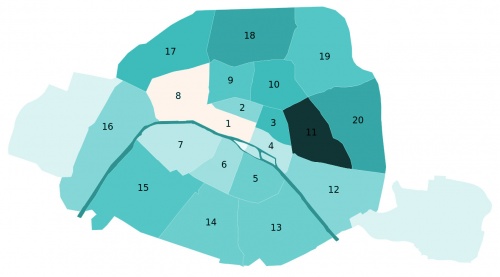Paris - La Belle Époque
- Paris -P33- Past Imperfect
Contents
- 1 Quote
- 2 Appearance
- 3 City Device
- 4 Climate
- 5 Demonym
- 6 Economy
- 7 Geography
- 8 History
- 9 Population
- 10 Arenas
- 11 Attractions
- 12 Bars and Clubs
- 13 Cemeteries
- 14 City Government
- 15 Crime
- 16 Citizens of the City
- 17 Corax of Paris
- 18 Current Events
- 19 Fortifications
- 20 Galleries
- 21 Gallû of Paris =
- 22 Holy Ground
- 23 Hospitals
- 24 Hotels & Hostels
- 25 Landmarks
- 26 Law Enforcement
- 27 Lupines of Paris
- 28 Mages of Paris
- 29 Mass Media
- 30 Monuments
- 31 Museums
- 32 Parks
- 33 Private Residences
- 34 Restaurants
- 35 Ruins
- 36 Schools
- 37 Shopping
- 38 Telecommunications
- 39 Theaters
- 40 Transportation
- 41 Vampires of the City
- 42 Websites
Quote
In Paris, everybody wants to be an actor; nobody is content to be a spectator. -- Jean Cocteau
Appearance
[[]]
City Device
Climate
Paris has a typical Western European oceanic climate which is affected by the North Atlantic Current. The overall climate throughout the year is mild and moderately wet. Summer days are usually moderately warm and pleasant with average temperatures hovering between 15 and 25 °C (59 and 77 °F), and a fair amount of sunshine. Each year, however, there are a few days where the temperature rises above 30 °C (86 °F). Some years have even witnessed some long periods of harsh summer weather, such as the heat wave of 2003 where temperatures exceeded 30 °C (86 °F) for weeks, surged up to 39 °C (102 °F) on some days and seldom cooled down at night. More recently, the average temperature for July 2011 was 17.6 °C (63.7 °F), with an average minimum temperature of 12.9 °C (55.2 °F) and an average maximum temperature of 23.7 °C (74.7 °F).
Spring and autumn have, on average, mild days and fresh nights, but are changing and unstable. Surprisingly warm or cool weather occurs frequently in both seasons. In winter, sunshine is scarce; days are cold but generally above freezing with temperatures around 7 °C (45 °F). Light night frosts are however quite common, but the temperature will dip below −5 °C (23 °F) for only a few days a year. Snowfall is uncommon, but the city sometimes sees light snow or flurries with or without accumulation.
Rain falls throughout the year. Average annual precipitation is 652 mm (25.7 in) with light rainfall fairly distributed throughout the year. The highest recorded temperature is 40.4 °C (104.7 °F) on July 28, 1948, and the lowest is a −23.9 °C (−11.0 °F) on December 10, 1879.
Demonym
Parisian
Economy
Geography
Paris is located in northern central France. By road it is 450 kilometres (280 mi) south-east of London, 287 kilometres (178 mi) south of Calais, 305 kilometres (190 mi) south-west of Brussels, 774 kilometres (481 mi) north of Marseilles, 385 kilometres (239 mi) north-east of Nantes, and 135 kilometres (84 mi) south-east of Rouen. Paris is located in the north-bending arc of the river Seine, spread widely on both banks of the river, and includes two inhabited islands, the Île Saint-Louis and the larger Île de la Cité, which forms the oldest part of the city. The river’s mouth on the English Channel (La Manche) is about 233 mi (375 km) downstream of the city. Overall, the city is relatively flat, and the lowest point is 35 m (115 ft) above sea level. Paris has several prominent hills, of which the highest is Montmartre at 130 m (427 ft). Montmartre gained its name from the martyrdom of Saint Denis, first bishop of Paris atop the "Mons Martyrum" (Martyr's mound) in 250 A.D.
Excluding the outlying parks of Bois de Boulogne and Bois de Vincennes, Paris occupies an oval measuring about 87 km2 (34 sq mi) in area, enclosed by the 35 km (22 mi) ring road, the Boulevard Périphérique. The city's last major annexation of outlying territories in 1860 not only gave it its modern form but also created the twenty clockwise-spiralling arrondissements (municipal boroughs). From the 1860 area of 78 km2 (30 sq mi), the city limits were expanded marginally to 86.9 km2 (33.6 sq mi) in the 1920s. In 1929, the Bois de Boulogne and Bois de Vincennes forest parks were officially annexed to the city, bringing its area to about 105 km2 (41 sq mi). The metropolitan area of the city is 2,300 km2 (890 sq mi).
Arrondissements
Introduction
The city of Paris is divided into twenty arrondissements municipaux, administrative districts, more simply referred to as arrondissements. These are not to be confused with departmental arrondissements, which subdivide the 101 French départements. The word "arrondissement", when applied to Paris, refers almost always to the municipal arrondissements listed below. The number of the arrondissement is indicated by the last two digits in most Parisian postal codes (75001 up to 75020).
History
The oldest traces of human occupation in Paris, discovered near rue Henri-Farman in the 15th arrondissement in 2008, are human bones and evidence of an encampment of hunter-gatherers dating from about 8000 b.c., during the Mesolithic period. Between 250 and 225 BC, the Parisii, a sub-tribe of the Celtic Senones, settled on the Île de la Cité and on the banks of the Seine, built bridges and a fort, minted coins, and began to trade with other river settlements in Europe.
In 52 BC, a Roman army led by Titus Labienus defeated the Parisii, and established a Gallo-Roman garrison town called Lutetia. The town was Christianized in the 3rd century AD, and after the collapse of the Roman Empire was occupied by Clovis I, the King of the Franks, who made it his capital in 508.
During the Middle Ages, Paris was the largest city in Europe, an important religious and commercial center, and the birthplace of the Gothic style of architecture. The University of Paris on the Left Bank, organized in the mid-13th century, was one of the first in Europe. It suffered from the Bubonic Plague in the 14th century, and the Hundred Years War in the 15th century, with recurrence of the plague. Between 1418 and 1436, the city was occupied by the Burgundians and English soldiers. In the 16th century, Paris became the book-publishing capital of Europe, though it was shaken by the French Wars of Religion between Catholics and Protestants. In the 18th century, it was the center of the intellectual ferment called the Enlightenment, and the main stage of the French Revolution from 1789 which is remembered every year on the 14th of July with a military parade.
In the 19th century, Napoleon I embellished the city with monuments to military glory. It became the European capital of fashion, and the scene of two more revolutions in 1830 and 1848. Under Napoleon III and his Prefect of the Seine, Georges-Eugène Haussmann, between 1852 and 1870 the center of Paris was rebuilt with wide new avenues, squares and new parks, and the city was expanded to its present limits in 1860. In the latter part of the century, millions of tourists came to see the Paris International Expositions and the new Eiffel Tower.
In the 20th century, Paris suffered bombardment in the first World War and German occupation from 1940 until 1944 in the second World War. Between the two wars, Paris was the capital of modern art and a magnet for intellectuals, writers and artists from around the world. The population reached its historic high of 2.1 million in 1921, but declined for the rest of the century. New museums (The Centre Pompidou, Musée Marmottan Monet and Museé d'Orsay) were opened, and the Louvre given its glass pyramid.
Population
- -- City (2,891,020) - 1931 census
- -- Urban (5,674,419) - 1931 census
Arenas
Attractions
Bars and Clubs
Cemeteries
City Government
Crime
Citizens of the City
Corax of Paris
Current Events
Fortifications
Galleries
Gallû of Paris =
Holy Ground
Hospitals
Hotels & Hostels
Landmarks
Law Enforcement
Lupines of Paris
Bone Gnawers
Get of Fenris
Glass Walkers
Shadow Lords
Mages of Paris
Technocracy
Tradition
Mass Media
Monuments
Museums
Parks
Private Residences
Restaurants
Ruins
Schools
Shopping
Telecommunications
Theaters
Transportation
Vampires of the City
The Legacy of Villon: The Edicts
"The Edicts are written in English for understanding, and in French for mood purpose."
L'Art / The Art
Vous ne devrez ni voler, ni détruire, ni altérer un Objet d'Art sans l'Autorisation de l'Ancien parmi les Anciens. Aucun
Objet d'Art ne doit sortir du Territoire de France sans l'Autorisation de l'Ancien parmi les Anciens.
You must not steal, destroy, or alter an Object of Art without the Authorization of the Eldest among you.
No Object of Art is to exit the domain of France without the Authorization of the Eldest among you.
L'Elysée / The Elysium
Les Lieux protégé par l'Elysée ne pourront être le théatre de violence, ni de la Chasse. Provoquer la violence ou Chasser
dans l'Elysée sans l'Autorisation de l'Ancien parmi les Anciens est passible d'une Chasse de Sang. Par mesure de sécurité,
l'accès de certains Elysées sera réglementé.
Grounds protected by the Elysium will not be sullied by violence of hunt. Provoke violence or hunting in an Elysium
without the authorization of the Eldest among you can be punished by the Blood Hunt. For security reasons, the access to
some Elysiums will be limited.
L'Ordre / Order
L'ordre doit être garanti par le Prince, qui s'approprie donc de manière exclusive les moyens d'assurer
l'ordre et le bien-être de la Famille comme du Bétail. Il est par consécquent formellement interdit d'influencer
les forces de polices et les forces armées.
Les Masques et les Veilleurs, étant les representants du Prince, ne sont pas soumis à cet Edit.
Order is to be guarranteed by the Prince, who thus gather exclusively for himself the means to warrant the order and well
being of Kindred and Kine. Thus it is strictly forbidden to influence the police and army forces.
The Masques, being the representatives of the Prince, are not submitted to this Edict.
Diablerie / Diablerie
La Diablerie est un acte infâme indigne de notre Condition. Tout Caïnite convaincu de Diablerie sera passible d'une Chasse
de Sang, et ce, quel qu'ait été le Calice, ou l'endroit du crime.
Diablerie is an atrocious action under our condition. Any Kindred guilty of Diablerie can be Blood Hunted,
no matter who was the victim and where it happened.
L'Amaranthe / The Amaranth
Ceux qui se seront montré particulièrement indigne de leur Sang pourront voir leur Sang arraché par l'Amaranthe. Seuls
ceux qui auront été dignes des Traditions et Edits de Paris pourront se voir peut-être accordé par l'Ancien parmis les
Anciens, l'Amaranthe.
Those who acted in ways unworthy of their Blood can be subject to the Amaranth. Those who acted in ways worthy of their
Blood and of the Traditions and Edicts can be given the right of Amaranth by the Eldest among you.
La Magye / The Magick
Pratiquer les rituels magiques en présence d'un Mage est strictement interdit, tout comme tout contact avec eux.
Leur guerre d'ascension n'est pas la nôtre. Clan Tremere Le retour à Paris est conditionné par le comportement de leurs membres.
Les Veilleurs ne sont pas soumis à cet édit.
Praticing magic rituals in presence of a Mage is strictly forbidden, as is any contact with them. Their Ascensíon war is not our own. Clan Tremere Returning to
Paris is conditioned by the behaviour of their members.
The Veilleurs are not submitted to this Edict.
Assamites
Brujah
- -- Benedicte Dalouche -- Currently in Berlin...but wanting to return.
- -- L'Homme de Peu de Foi
- -- Saint Just 8th Generation, childe of Robin Leeland, sire of Karl.
- -- Thomas Frère(Thomas, Brother); 6th Generation Duc of the Brujah.
The Bâtards/ Catiff
Daughters of Cacophony
Gangrel
Malkavian
Nosferatu
Toreador
- - Francois Villon -- Domain: The Louvre {Location: Right Bank of the Seine in the 1st arrondissement.}
- - Arnaud -- Domain: Club Elysée {Location: 8th Arrondissement}
- - Carla Gagnon -- Domain: Église de Saint-Nicolas-du-Chardonnet {Location: 5th Arrondissement}
- - Maxime -- Domain: Saint-Georges -- A neighborhood of Pigalle -- Maxime has a loft above the vaunted SACEM building that he uses as his haven. {Location: 9th Arrondissement}
- - Bernard -- Domain: The Louvre {Location: Right Bank of the Seine in the 1st arrondissement.} -- As the Seneschal of Paris, Bernard resides with his sire in the Louvre.
- - Chevalier d'Eglantine -- Domain: Les Invalides {Location: 7th Arrondissement}
- Merevith
- - Elle Emilie Nicoline
- - Lazlo Guerin -- Domain: Palais Bourbon {Location: 7th Arrondissement}
- - Florient (Deceased)
- - Versancia
- - Violetta Desjardins
- - Arnaud -- Domain: Club Elysée {Location: 8th Arrondissement}
Tremere
True Brujah
Ventrue
Websites
https://en.wikipedia.org/wiki/Paris_between_the_Wars_(1919%E2%80%931939)


